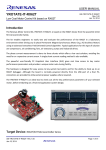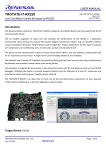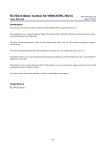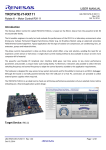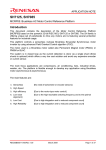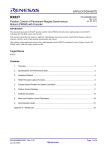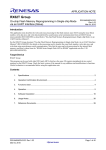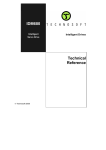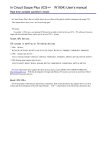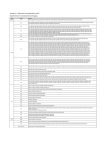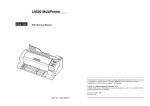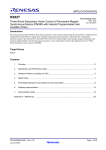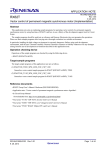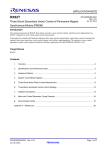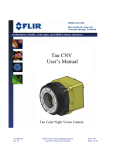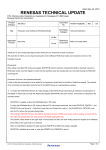Download User`s manual
Transcript
MCRP07 RX62T USER’S MANUAL LOW COST MOTOR CONTROL DEMO BOARD BASED ON RENESAS RX62T Introduction This document describes the Motor Control Reference Platform [MCRP07] based on the new powerful 32‐ bit Renesas MCU RX62T. This platform drives a 3‐phase Permanent Magnet Synchronous Motor (Brushless Motor) by using an advanced sensor‐less Field Oriented Control algorithm. The phase currents measurement is done via three shunts which offer a very low cost solution avoiding any expensive current sensor; single shunt current reading is also possible. The main focus applications for this type of algorithm are compressors, air conditioning, fans, industrial drives, washer, etc. The platform allows easy custom applications development, including an on‐board small motor and a user‐ friendly PC user interface. The platform can be powered directly by USB, or it’s possible to provide an external power supply and in this case the USB communication is optically insulated. An external power stage can be managed, in order to control higher power motors. With this demo system you can experience a new and easier way to deal with motor control, you can develop and test your own solutions, thanks to the power of the new Renesas MCUs. Version 1.0 September 2010 Page 1 of 34 MCRP07 RX62T USER’S MANUAL Contents Introduction ...................................................................................................................................................................... 1 Contents............................................................................................................................................................................ 2 Hardware overview........................................................................................................................................................... 3 Power supply selection ..................................................................................................................................................... 5 LEDs function description ................................................................................................................................................. 6 Internal power stage brief description ............................................................................................................................. 7 Interface with an external power stage............................................................................................................................ 8 Example of connection with an external power stage ................................................................................................... 12 Control MCU overview.................................................................................................................................................... 13 Permanent magnets brushless motor model ................................................................................................................. 15 Sensor‐less F.O.C. algorithm ........................................................................................................................................... 21 Software description....................................................................................................................................................... 22 Start‐up procedure.......................................................................................................................................................... 25 Reference system transformations in details ................................................................................................................. 27 PWM modulation technique........................................................................................................................................... 28 List of variables used in “motorcontrol.c” ...................................................................................................................... 29 Cautions .......................................................................................................................................................................... 34 Version 1.0 September 2010 Page 2 of 34 MCRP07 RX62T USER’S MANUAL Hardware overview MCRP07 is a single board inverter, based on the new RX series microcontroller RX62T. The hardware includes a low‐voltage MOSFETs power stage, and a communication stage. To obtain the maximum flexibility, the demo board includes: • A complete 3‐phase inverter on‐board with a low voltage motor, so it becomes easy to test the powerful sensor‐less algorithm on the RX62T. • USB communication with the PC via a H8S2212 MCU. • Connectors for hall sensors and encoder connections. • Compatibility with the existing Motor Control Reference Platforms MCRP05/06 power stage. To achieve these aims, an independent communication stage was implemented, based on the Renesas microcontroller H8S2212, which performs the USB to serial conversion (the two serial lines RX and TX are easier to insulate). This stage uses the PC USB power lines as power supply. Furthermore, the possibility to supply all the board using the PC USB port was added, realizing a step‐up converter to obtain the inverter VBUS necessary for the motor; obviously, if this feature is used, the system is no more insulated from the PC. INSULATION POWER STAGE STEP‐DOWN STEP UP EXTERNAL POWER STAGE INTERFACE CONTROL STAGE Version 1.0 HALL, ENCODER September 2010 COMMUNICATION Page 3 of 34 MCRP07 RX62T USER’S MANUAL If external power supply is used for the inverter, the logic power supply is obtained through a step‐down converter, in order to reduce heating and power consumption. Please refer to the electrical drawings to get the hardware implementation details. Version 1.0 September 2010 Page 4 of 34 MCRP07 RX62T USER’S MANUAL Power supply selection As stated before, there are two ways to supply power to the board. One possibility is to use directly the PC USB supply, and in this case the current you can give to the motor is limited by the USB possibilities. A dual power USB cable is recommended to give enough power to the board. The second possibility is to use an external voltage DC source to supply the board. The recommended voltage values are between 12VDC and 24VDC. In this case the communication stage is insulated from the inverter. The selection between the two possibilities is made through three jumpers in the J2 connector, as described in the following figure. 9 4 1 9 4 1 8 5 2 8 5 2 7 6 3 7 6 3 PC USB SUPPLY SELECTION EXTERNAL SUPPLY SELECTION The first jumper configuration connects the USB ground to the inverter ground, the USB 5Vdc to the logic +5Vdc and the output of the step‐up converter (around 13Vdc) to the inverter DC link. The second jumper configuration connects the external power supply ground to the inverter ground, the output of the step‐down converter (+5Vdc) to the logic +5Vdc and the external +Vdc (from 12 to 24 Vdc) to the inverter DC link. Version 1.0 September 2010 Page 5 of 34 MCRP07 RX62T USER’S MANUAL LEDs function description Three LEDs available on the board are directly connected to the hardware and allows the user to understand the status of the supply of the board. Please refer to the LED map for the following indications: • DL8 is connected to the USB supply, so it indicates that the USB port is supplied (and, by consequence, all the communication section); • DL7 is connected to the step‐down converter output, and it is on only if an external power supply is connected; • DL9 is connected to the logic supply, so it indicates that the control section is supplied. DL8 DL7 DL4 DL9 DL1 DL6 The other LEDs in the board are driven via software, in particular: • DL6 is blinking if there is a communication between the PC and the board; • DL1 is blinking if the control section MCU (RX62T) is running normally. • DL4 is blinking (quickly) if an alarm has been detected. Version 1.0 September 2010 Page 6 of 34 MCRP07 RX62T USER’S MANUAL Internal power stage brief description The power stage is a complete 3‐phase bridge composed with discrete low voltage power MOSFETs, mounted on the bottom side of the board. The MOSFETs are the Renesas RJK0654DPB n‐channel power MOSFETs (please refer to the data‐sheet for the characteristics). On the upper side of the board is mounted the MOSFETs driving circuit, composed with discrete elements (refer to the electric drawings). 3 PHASES BRIDGE CURRENT READING SHUNTS The current reading shunts are also in the bottom side of the board, while the signal conditioning circuit is in the upper side. The inverter has the classical schema with the three shunts on the lower arms: Version 1.0 September 2010 Page 7 of 34 MCRP07 RX62T USER’S MANUAL Interface with an external power stage Since internal power stage allows only the management of small motors, an interface with an external power stage was added. This was made easy due to the presence in the microcontroller of several timer sections that make it possible to manage more than one motor. Pls. find below the schematic of the connectors present in the board, used for connecting an external power stage. CONN. J12 JUMPER JP5 VBUS‐EXT 2 2 1 3 4 4 3 5 6 7 8 9 10 +5V 1 11 12 13 14 15 16 CONN. J11 MTIOC3D (UP53) PHASE U LOWER PWM DRIVE SIGNAL 1 2 MTIOC4C (UP52) PHASE V LOWER PWM DRIVE SIGNAL 3 4 MTIOC4D (UP51) PHASE W LOWER PWM DRIVE SIGNAL 5 6 MTIOC3B (UP56) PHASE U UPPER PWM DRIVE SIGNAL 7 8 MTIOC4A (UP55) PHASE V UPPER PWM DRIVE SIGNAL 9 10 MTIOC4B (UP54) PHASE W UPPER PWM DRIVE SIGNAL 11 12 POE0 (UP57) HARDWARE ALARM SIGNAL 13 14 100R 10N 15 16 NM +5V Version 1.0 September 2010 Page 8 of 34 MCRP07 RX62T USER’S MANUAL AN103 (UP84) VBUS VOLTAGE SIGNAL AN101 (UP86) V PHASE CURRENT SIGNAL AN102 (UP85) U PHASE CURRENT SIGNAL 100R 100R 1N 100R 1N 1N +5V +5V +5V MTIC5U (UP96) U PHASE COMM. SIGNAL 1K 3 4 5 6 7 8 9 10 13 14 +5V 15 16 MTIC5V (UP97) V PHASE COMM. SIGNAL 2 11 12 15K 1 17 18 1K 19 20 15K 21 22 +5V 23 24 MTIC5W (UP98) W PHASE COMM. SIGNAL 1K 25 26 AN100 (UP87) W PHASE CURRENT SIGNAL 100R 15K CONN. J13 +5V 1N +5V AN2 (UP75) THERMAL SENSOR SIGNAL 1K 10K 10K +5V 100N +5V The interface between the board and an external power stage is organized as follows: a) A 16 pins connector (J11) is used for the PWM drive signals; the signals are directly connected to the microcontroller output pins, and there is no pull‐up or pull‐down resistor connected, so the polarization has to be done in the power stage (note that in case of alarm, the microcontroller output pins can be placed in high impedance state, so the external polarization is necessary); these output commands are logic level signals, with limited current output capability, so an external driver is probably required. A further line is connected to the microcontroller: it is the external alarm signal, connected to the POE input pin; this pin is not polarized, so if the POE is enabled and the input is leaved unconnected, undesired alarms can occur. All the free pins of the connector are connected to the board ground to minimize the cross talking of the lines if a flat cable is used. Version 1.0 September 2010 Page 9 of 34 MCRP07 RX62T USER’S MANUAL b) A 26 pins connector (J13) is used to collect some signals from the power stage, in particular the current readings and the DC link voltage reading; those signals are clamped and weakly filtered, then directly connected to the A/D converter input pins of the microcontroller, so the external power stage has to take care of the gain and the offset of these signals. An input is dedicated also to a thermal sensor, and a pull‐up resistor is present. Three further signals are managed: they are the commutation signals from the output phases, useful if the hardware compensation of dead‐ times facility of the MTU is used; those signals are clamped with a diode directly connected with the microcontroller power supply, so a suitable series resistance is needed in the power stage to avoid damages to the board. c) A further connector (J12) can be used to supply the board from the power stage or vice‐versa (making a short circuit between the pins 1 and 2 of the jumper JP5); also the board 5V can be make available to the power board (making a short circuit between the pins 3 and 4 of JP5), but not vice‐ versa, because they are directly connected to the step‐down switching supply of the board. The ground connection is always on, and it represents the reference for all the interface signals. In the next figure a simple example regarding how the power board has to be arranged is presented: the power supply comes from the supply connector, and the supply for power module is derived from it. The external supply is also used to supply the microcontroller board through the connector J12A (and the jumper JP5 in microcontroller board); the 5V supply for current sensors and for the signal polarization is derived from the microcontroller board, through J12A (and JP5). The PWM drive signals are taken from J11A, while the current sensing signals and the bus voltage measurement are brought to J13A (the phase commutation signals and the temperature sensing signal are not reported for sake of simplicity). Pls. refer to the complete schematics for further details. Version 1.0 September 2010 Page 10 of 34 MCRP07 RX62T USER’S MANUAL +5V +15V +24V VCC VBUS 1 2 UL 3 4 VL OUT U 5 6 WL 7 8 UH Intelligent Power Module OUT V 9 10 VH WH 1 Current Sensor 13 14 ALRM 15 16 GND OUT W 2 +5V MOTOR Current Sensor PWGND +5V +24V +15V Voltage regulator +24V 1 2 SUPPLY +5V 1 2 3 4 5 6 7 8 9 10 1 2 11 12 3 4 13 14 5 6 15 16 7 8 17 18 9 10 19 20 11 12 21 22 13 14 23 24 15 16 25 26 CONN. J12A Version 1.0 +5V 3 11 12 CONN. J11A Current Sensor September 2010 CONN. J13A Page 11 of 34 MCRP07 RX62T USER’S MANUAL Example of connection with an external power stage The interface for an external power supply was designed to be compatible with the power stages of previous Renesas motor control demo platforms MCRP05/06. The schematic of such a power stage has been included in the documentation of the present board. A picture of the two board connected can be found below. JP2 MOTOR CONNECTOR JP5 DC BUS CONNECTOR POWER SUPPLY CONNECTOR J12 J11 J13 The power supply (24Vdc) is furnished trough the power board, and comes to the microcontroller board through the jumper JP5, in which the pin 1 and 2 are short‐circuited, while the 3 and 4 are leaved open. In the microcontroller board, the supply configuration jumper JP2 is configured in order to select the external supply (not the USB one). In the MCRP05 power board, a DC bus connector allows the user to have (only for the motor) a higher external DC voltage; in such way high voltage motors can be managed. Version 1.0 September 10 Page 12 of 34 MCRP07 RX62T USER’S MANUAL Control MCU overview The RX62T Group is a set of MCUs featuring the high‐speed, high‐performance RX CPU as the 100MHz processor core. Each basic instruction of the processor is executable in one cycle of the system clock. Calculation functionality is enhanced by the inclusion of a single‐precision floating‐point calculation unit as well as a 32‐bit multiplier and divider. Additionally, code efficiency is improved by instructions with lengths that are variable in byte units to cover an enhanced range of addressing modes. A multi‐functional timer pulse unit 3 (for motor control), general PWM timer, compare match timers, watchdog timer, independent watchdog timer, serial communications interfaces, I2C bus interfaces, CAN module, serial peripheral interface, LIN module, 12‐bit A/D converters with three‐channel simultaneous sampling function, and 10‐bit A/D converter are incorporated as peripheral functions which are essential to motor control devices. In addition, the 12‐bit A/D converters include a window comparator and programmable gain amplifier for additional functionality. Please find below the summary of the RX62T features: RX600 CPU High‐speed: 100MHz clock High performance: 1.65MIPS/MHz Low current consumption: only 50mA @ 100MHz Single‐precision floating point unit FPU, barrel shifter, MAC, RMPA 256kB Flash/16kB RAM to 64kB Flash/8kB RAM Zero wait access to Flash memory 64pin – 112pin package options Functions Enhanced PWM resolution with MTU3, enhanced PWM functionality with GPT 12‐bit A/D converter (1µs) : 4 channels x 2 unit , 10‐bit A/D converter (1µs) : 12 channels x 1 unit Three S/H circuits for each unit: Three shunts control enable Double data registers for each unit: 1 shunt control enable Programmable gain Operational amplifier, Window comparator for Voltage monitoring CAN option Large‐capacity flash memory units capable of high‐speed operation are included as on‐chip memory, significantly reducing the cost of configuring systems. Version 1.0 September 10 Page 13 of 34 MCRP07 RX62T USER’S MANUAL The main application fields of this MCU are: industrial equipment, household electrical appliances, machines requiring motor control, and inverter‐powered machines. Please find below the block diagram of the RX62T and the role of each peripherals. RX CPU 100MHz 2.7~3.6V (4.0‐5.5V) Flash Data Flash 8KB FPU Multiplier‐divider and multiplier‐accumulator I/O ports SCI x 3 ch SPI x 1ch POR/LVD I C x 1 ch RCAN x 1ch 16‐bit timer x 4 ch (CMT) GPT 1ph, PWM with dead time Inverter control,PFC etc 1ph, PWM with dead time Inverter control,PFC etc 1ph, PWM with dead time Inverter control,PFC etc 1ph, PWM with dead time Inverter control,PFC etc Protection ‐ External input (POE) ‐Clock stop detection ‐Clock monitoring 6 OpAmp 6 comp 12bit AD 4ch Self diagnostic Serial communication 2 CRC Maximum current & VBUS management RAM Watchdog timer x 2 ch (One of two includes the LOCO) OCO (Low speed) DTC MTU3 IPM 3ph. PWM with dead time (Use two 16‐bit timer ch3&4) 3ph. PWM with dead time (Use two 16‐bit timer ch6&7) M M 1 or 2 Encoder Input (Use 1or2 16‐bit timer ch1/2) 12bit AD 4ch Self diagnostic POE Hall sensor / BEMF Input (Use one 16‐bit timer ch0) Dead time compensation (Use one 16‐bit timer ch5) PMAC fault Motor 10‐bit ADC x 12ch Shunts reading Version 1.0 September 10 Page 14 of 34 MCRP07 RX62T USER’S MANUAL Permanent magnets brushless motor model The synchronous permanent magnets motor (sinusoidal brushless motor) is widely used in the industry. More and more home appliance makers are now using such brushless motor, mainly because of the intrinsic motor efficiency. The permanent magnet motor is made with few components: 1. A stator formed by stacking sheared metal plates where internally the copper wiring is wound, constructing the stator winding 2. A rotor in which permanent magnets are fixed 3. Two covers with ball bearings that keep together the stator and the rotor; the rotor is free to rotate inside the stator “a” winding “b” winding ia Motor axis (shaft) + va “a” winding magnetic axis ic ib vb “c” winding + vc + How current flows into “a” winding The working principle is quite simple: if we supply the motor with a three‐phase system of sinusoidal voltages, at constant frequency, in the stator windings flow sinusoidal currents, which create a rotating magnetic field. The permanent magnets in the rotor tend to stay aligned with the rotating field, so the rotor rotates at synchronous speed. The main challenge in driving this type of motor is to know the rotor position in real‐time, so mainly implementation are using a position sensor or a speed sensor. In our implementation, the system is using either one or three shunts to detect the rotor position in real‐ time. Version 1.0 September 10 Page 15 of 34 MCRP07 RX62T USER’S MANUAL Let’s analyse the motor from a mathematic point of view. If we apply three voltages va(t), vb(t), vc(t) to the stator windings, the relations between phase voltages and currents are: dλa dt dλ vb = RS ib + b dt dλ vc = RS ic + c dt v a = RS i a + ‐ λi is the magnetic flux linkage with the i‐th stator winding ‐ RS is the stator phase resistance (the resistance of one of the stator windings) The magnetic flux linkages λi are composed by two items, one due to the stator currents, one to the permanent magnets. β axis c axis a α c’ b’ a axis c α axis α’ a’ ϑ β’ b Λm β’ b axis Real axes (a, b, c) and equivalent ones (α, β); a fixed amplitude vector can be completely determined by its position respect the (α, β) system (angle ϑ) The permanent magnet creates a magnetic field that is constant in amplitude and fixed in position in respect to the rotor. This magnetic field can be represented by vector Λm whose position in respect to the stator is determined by the angle ϑ between the vector direction and the stator reference frame. The contribution of the permanent magnets in the flux linkages depends on the relative position of the rotor and the stator represented by the mechanical‐electric angle ϑ. Version 1.0 September 10 Page 16 of 34 MCRP07 RX62T USER’S MANUAL It is, in every axis, the projection of the constant flux vector Λm in the direction of the axis: λa = Lia + Λ m cos(ϑ ) λb = Lib + Λ m cos(ϑ − 2π 3 ) λc = Lic + Λ m cos(ϑ − 4π 3 ) Supposing that the rotor is rotating at constant speed ω (that is: ϑ(t) = ωt) the flux linkages derivatives can be calculated, and we obtain: dia − ωΛ m sin(ϑ ) dt di vb = RS ib + L b − ωΛ m sin(ϑ − 2π ) 3 dt di vc = RS ib + L b − ωΛ m sin(ϑ − 4π ) 3 dt v a = RS i a + L A “three phases system” may be represented by an equivalent “two phases system”. So the by using specific transformations, our three equations system is equivalent to a two equations system. It is basically a mathematical representation in a new reference coordinates system. In the two phases (α,β) fixed system the above equations become: vα = RS iα + v β = RS i β + dλα dt dλβ dt For the magnetic field equations, we got: λα = Liα + λαm = Liα + Λ m cos(ϑ ) λβ = Liβ + λβm = Liβ + Λ m sin(ϑ ) After performing the derivation: dλα di di = L α − ωΛ m sin(ϑ ) = L α − ωλβm dt dt dt dλβ diβ diβ =L + ωΛ m cos(ϑ ) = L + ωλαm dt dt dt Finally, we obtain for the voltages in (α,β) system: Version 1.0 September 10 Page 17 of 34 MCRP07 RX62T USER’S MANUAL diα − ωλβm dt diβ v β = RS i β + L + ωλαm dt vα = RS iα + L A second reference frame is used to represent the equations as the frame is turning at the rotor speed. So the “d” axis is chosen in the direction of the magnetic vector Λm, and with the “q” axis orthogonal to the “d” axis. The new reference system is (d, q). The reference frame transformations from the (α,β) system to the (d, q) system depends on the instantaneous position angle ϑ So we obtain two inter‐dependant equations in the (d, q) system: did − ωLiq dt diq v q = RS i q + L + ωLid + ωΛ m dt v d = RS i d + L These two equations represent the mathematical motor model. Vd 1/(R+sL) + Id + Lω e pL τload Vq + 1/(R+sL) Iq (3/2)pΛ τ + 1/(B+sJ) ω mec Λω e pΛ A control algorithm which wants to produce determined currents in the (d, q) system must impose voltages given from the formulas above. This is ensured by closed loop PI control on both axis “d” & “q” (Proportional Integral). Since there is a mutual influence between the two axes, decoupling terms can be used. Version 1.0 September 10 Page 18 of 34 MCRP07 RX62T USER’S MANUAL In the block scheme the mechanic part is included, where “p” is the number of pole pairs, while “B” represents friction, “J” the inertia, “τload“ the load torque and “τ” the motor torque. 3 2 τ = × p×Λ The angular speed ω is represented in the scheme as ωe to distinguish the electrical speed from the mechanical one. Let’s now consider the equations we have seen in (α,β) system: vα = RS iα + v β = RS i β + dλα dt dλβ dt These equations show that magnetic flux can be obtained from applied voltages and measured currents simply by integration: t λα = λα 0 + ∫ (vα −RS iα )dt 0 t λβ = λβ 0 + ∫ (vβ −RS iβ )d 0 Furthermore: Λ m cos(ϑ ) = λα − Liα Λ m sin(ϑ ) = λβ − Liβ If the synchronous inductance L is small, the current terms can be neglected, if not they have to be considered. In general: t x = Λ m cos(ϑ ) = λα − Liα = λα 0 + ∫ (vα −RS iα )dt − Liα 0 t y = Λ m sin(ϑ ) = λβ − Liβ = λβ 0 + ∫ (vβ −RS iβ )dt − Liβ 0 So in the (α,β) system phase we obtain from the flux components: ϑ = arctan( x y ) Version 1.0 September 10 Page 19 of 34 MCRP07 RX62T USER’S MANUAL The system speed ω can be obtained as the derivative of the angle ϑ. ω= d ϑ (t ) dt Based on this, a sensor‐less control algorithm was developed to give the imposed phase voltages, to measure phase currents, to estimate the angular position ϑ and finally the system speed. Version 1.0 September 10 Page 20 of 34 MCRP07 RX62T USER’S MANUAL Sensor‐less F.O.C. algorithm Please, find below the sensor-less FOC algorithm block diagram. 0 [Idref] Id PI + Vd Vq (d, q) → (α, β) Vα Vβ PWM Modulation (α, β) → (u, v, w) Motor ‐ ωref Speed PI Iqref + + ‐1 z z ‐1 z ‐1 z ‐1 z Current ‐1 Reading (z ) ‐1 ‐ ‐ Iq PI ωest Speed estimation Idmea Iqmea ϑest (α, β) → (d, q) Flux Phase estimation Iαmea Iβmea (u, v, w) → (α, β) Iumea Ivmea The only difference between the three shunts configuration and the single shunt one is in the “Current Reading” block, the rest of the algorithm remains the same. Version 1.0 September 10 Page 21 of 34 MCRP07 RX62T USER’S MANUAL Software description On MCRP07 this software is working on RX62T [100MHz], which is a huge microcontroller for this kind of algorithm. This allows the user to realize virtually what he wants in addition. The total software uses the following resources: 1) FLASH : < 18Kbytes 2) RAM : < 3Kbytes Pls. Note that these data include also the communication interface and the demo board management. The following flow charts show the software implementation of the motor control part of the software Software organization Hardware and software initialization Interrupt enabling 100µs Interrupt 10ms Main loop Version 1.0 September 10 Page 22 of 34 MCRP07 RX62T USER’S MANUAL Main Program Eeprom parameters upload A/D channels offset reading Peripherals initialization Variables initialization Interrupt enabling Main loop synchronization cnt_int == 0 ? NO YES cnt_int = NUM_INT Main loop body Speed ramp management Communication management General board management Parameters modification management Version 1.0 September 10 Page 23 of 34 MCRP07 RX62T USER’S MANUAL Control Interrupt Phase currents (iumea, ivmea) reading Transformations (using the phase angle ϑ): (iumea, ivmea) → (iamea, ibmea) → (idmea, iqmea) Read DC Link voltage vbus Phase angle update: ϑ = ϑnew Current PI controls use (idref, iqref), (idmea,iqmea) to produce (vdout, vqout) Transformations (using the phase angle ϑ): (vdout, vqout) → (vaout, vbout) → (vuout, vvout) PWM output commands generation (using vuout, vvout) vbus is used to calculate maximum phase voltage (used in current PI controls) Phase estimation based on old_vaout, old_vbout, iamea, ibmea, produces new estimated phase angle ϑest Voltage memories update: old_vaout = vaout, old_vbout = vbout Speed estimation produces ωest Estimation errors detection (if errors an alarm is produced) YES NO Start‐up in progress? Start‐up procedure produces idref, iqref, ϑstup idref = 0 ϑnew = ϑstup Speed PI control uses (ωref, ωest) to obtain iqref ϑnew = ϑest Main loop synchronization cnt_int > 0 ? NO YES ‐‐cnt_int Version 1.0 September 10 Page 24 of 34 MCRP07 RX62T USER’S MANUAL Start‐up procedure When the motor is in stand‐still, the phase of the permanent magnet flux vector cannot be detected with the used algorithm. So an appropriate start‐up procedure has to be applied. The idea is to move the motor in feed‐forward (with higher current than that required to win the load), till a speed at which the estimation algorithm can work. Then the system can be aligned to the estimated phase, and the current can be reduced to the strictly necessary quantity. The following graph illustrates the strategy used (the suffix “ref“ stands for reference, the suffix “mea“ stands for measured). idref idmea iqref iqmea sstart istart id0 speedref iq0 t0 t1 t2 t3 t Referring to the graph, the startup procedure (in case of three shunts current reading) is described below. a) At the beginning t0, the system phase is unknown. No current is imposed to the motor; the system phase is arbitrarily decided to be ϑa=0. All the references: idref, iqref and speedref are set to zero. b) From the moment t0, while the iqref and the speedref are maintained to zero, idref is increased with a ramp till the value istart is reached at the moment t1. The references are referred to an arbitrary (da, qa) system based on the arbitrary phase ϑa. From this moment, the phase estimation algorithm begins to be performed, and the estimated phase ϑest is used to calculate the components of the measured current, referred to the (d, q) system based on the estimated phase, idmea and iqmea. The components of the current referred to the arbitrary (da, qa) system are controlled to follow the references by the current PI controllers. On the other hand, since the phase ϑest is still not correctly estimated, idmea and iqmea have no physical meaning. Even if they are not shown in the Version 1.0 September 10 Page 25 of 34 MCRP07 RX62T USER’S MANUAL graph, the applied voltages are subjected to the same treatment (vdmea and vqmea are calculated in the algorithm). c) At t = t1, while iqref is maintained to zero and idref is maintained to its value istart, speedref is increased with a ramp till the value sstart is reached at the t = t2. The system phase ϑa(t) is obtained simply by integration of speedref; in the meanwhile, the phase estimation algorithm begins to align with the real system phase. Furthermore idmea and iqmea begin to be similar to the real flux and torque components of the current. The real components are supposed to be id0 and iq0 (those values are obtained applying a low‐pass filter to idmea and iqmea). The interval (t2‐t1) is the start‐up time, and it is supposed to be large enough to allow the estimation algorithm to reach the complete alignment with the real phase of the system. d) At t = t2, the phase estimation process is supposed to be aligned. At this point a reference system change is performed: from the arbitrary (da, qa) reference to the (d, q) reference based on the estimated phase ϑest. The current references are changed to the values id0 and iq0, and all the PI controllers are initialized with these new values. The speed PI integral memory is initialized with the value iq0, while the current PI integral memories are initialized with the analogous voltage values vd0 and vq0, obtained from vdmea and vqmea. e) After t > t2 , the normal control is performed, based on the estimated phase ϑest; the speed reference is increased with the classical ramp; the id current reference is decreased with a ramp, till it reaches the value zero at the moment t3; then it is maintained to zero; the iq current reference is obtained as output of the speed PI controller. Version 1.0 September 10 Page 26 of 34 MCRP07 RX62T USER’S MANUAL Reference system transformations in details Find below the detailed equations used for the coordinates transformations. 2 1 1 (gu − gv − g w ) = ga 3 2 2 2 3 3 1 1 gβ = ( gv − gw ) = (gv − g w ) = (gu + 2g v ) 3 2 2 3 3 gα = (u, v, w) → (α, β) g u = gα 1 g v = − gα + 2 1 g w = − gα − 2 3 g β = (− g α + 3 g β ) / 2 2 3 g β = (− g α − 3 g β ) / 2 2 (α, β) → (u, v, w) g d = g α cos(ϑ ) + g β sin(ϑ ) g q = − g α sin(ϑ ) + g β cos(ϑ ) (α, β) → (d, q) (d, q) → (α, β) gα = g d cos(ϑ ) − g q sin(ϑ ) g β = g d sin(ϑ ) + g q cos(ϑ ) ⎫ ⎧vu = V cos(ωt + ϕ 0 ) ⎪ ⎪ ⎧v d = V cos(ϕ 0 )⎫ ⎧vα = V cos(ωt + ϕ 0 )⎫ ⎨vv = V cos(ωt + ϕ 0 − 2π / 3) ⎬ ⎨ ⎬ ⎬ ⎨ ⎪v = V cos(ωt + ϕ − 4π / 3)⎪ 0 ⎭ ↔ ⎩v β = V sin(ωt + ϕ 0 ) ⎭ ↔ ⎩v q = V sin(ϕ 0 ) ⎭ ⎩ w Version 1.0 September 10 Page 27 of 34 MCRP07 RX62T USER’S MANUAL PWM modulation technique Among the various possibilities, a particular form of PWM modulation was chosen. In this modulation technique, the voltages to be imposed are shifted in order to have in every moment one of the three phases of the motor connected to the system ground. This allows reducing the commutations of the power bridge of one third, in respect to other modulation techniques. In fact the phase that is connected to the system ground doesn’t require any commutation, having the lower arm always on and the upper arm always off. The method is based on the fact that, having no neutral connection, we are interested only in phase‐to‐ phase voltages, or in the voltage differences between the phases, not in the voltage level of the single phases. This allows us to add or subtract an arbitrary quantity to the phase voltages, on condition that this quantity is the same for all the three phases. So, obtained from the algorithm the three phase voltages requests, the minimum is chosen and it is subtracted to all the three requests. With this method, the applied voltage star centre is not at a fixed level, but it is moving. VBUS The maximum phase‐to‐phase voltage that can be obtained (without distortion of the sinusoidal waveform) with this method is equal to the DC Link voltage, as in other methods (like Space Vector Modulation). Version 1.0 September 10 Page 28 of 34 MCRP07 RX62T USER’S MANUAL List of variables used in “motorcontrol.c” The file “motorcontrol.c” includes the motor control algorithm routines. Please find below the description of the variables used. Label(s) Type Description ium_off, ivm_off, iwm_off float A/D conversion offsets of measured u, v, w phase currents; the value is around 2048, that corresponds to one half of the A/D converter supply voltage (5Vdc) (12bit A/D). vol_ref float A/D conversion result of the reading of the reference voltage (4.25V); used for compensate the effects of the power supply variations in the A/D conversions; the ideal value is 870 (10bit A/D), if the A/D converter supply voltage is exactly 5V. kadi, kadv float Current and voltage conversion constants; they are corrected on the grounds of vol_ref, and they are used to convert the A/D results in the used measurement units; multiplying the A/D result by the conversion constant, the current (voltage) in Ampere (Volt) is obtained (ex.: iu=kadi*(iuad‐ium_off)) r_sta float Stator resistance ohm l_sync float Synchronous inductance henry c_poli float Number of polar couples krpmocp, ukrpmocp float Conversion constant between mechanical speed and electrical speed, and its reciprocal (ukrpmocp=1/krpmocp). (rad/s)/rpm, vstart float Startup voltage in single shunt operation; during startup, first a voltage ramp at zero speed is performed, then a voltage and speed ramp; vstart is the actual value. volt vs_off float Offset startup voltage in single shunt operation; vs_off is the total starting value (total voltage at zero speed). volt vs_inc float It is the quantity added at every zero speed ramp step to obtain vs_off. volt Version 1.0 Unit September 10 rpm/(rad/s) Page 29 of 34 MCRP07 RX62T USER’S MANUAL Label(s) Type Description Unit vs_del float Total voltage quantity added during startup in single shunt operation; added to vs_off, it gives the voltage applied when the voltage and speed ramp is finished. volt vs_dela float Voltage quantity added at every voltage and speed ramp step during startup in single shunt operation. volt istart float Startup current in three shunts operation; during startup, first a current ramp at zero speed is imposed, then a speed ramp with constant current (istart). ampere is_inc float Startup current increment at every step. ampere omegae_s float Electrical speed during startup (instant value) rad/s delta_om float Speed quantity added at every step during startup ramp. rad/s om_chg float Speed to reach during the startup; when this speed is reached, the startup ramp ends. rad/s startup_phase float Electrical phase during startup. rad delta_ph float Phase variation at every step during startup. rad vdx, vqx, vdxf, vqxf float D and q axis voltages (instant and filtered) during startup. volt idx, iqx, idxf, iqxf float D and q axis currents (instant and filtered) during startup. ampere SystemPhase float Imposed electrical phase. rad Phase_est float Estimated electrical phase. rad vbus, vbusf float DC link voltage, instant value and filtered one. volt xvbf float DC link voltage, minimum ripple value, used for voltage volt clamping. vfmax float Maximum allowed phase voltage (star). volt vdmax, vdmax float Maximum d and q axis allowed voltages. i_max, iq_max float Maximum allowed total current, maximum allowed q axis current. ampere D and q axis imposed voltages, instant and filtered values. volt vdc, vqc, vdcf, vqcf float Version 1.0 September 10 Page 30 of 34 MCRP07 RX62T USER’S MANUAL Label(s) Type Description Unit vac, vbc float Alpha and beta axis voltages. volt vuc, vvc, vwc float Phase voltages (star). volt old_va, old_vb float Previous step alpha and beta axis voltages. volt ium, ivm, iwm float Measured phase currents. ampere iam, ibm float Measured alpha and beta axis currents. ampere idm, iqm, idmf, iqmf float Measured d and q axis currents (instant and filtered values). ampere idr, iqr float D and q axis reference currents. ampere id_dec float After the startup, the d axis current residual is decreased till zero; id_dec is the variation at every step. ampere idint, iqint float Current PI integral memories. volt idimem, iqimem float volt Current PI integral memories; this values are used in single shunt operation to stop the integral action when the current reading is not possible. errint float Speed PI integral memory ampere kp_cur, ki_cur float Proportional and integral constant in current PI controllers. volt/ampere kp_vel, ki_vel float Proportional and integral constant in speed PI controller. ampere/(rad/s) freq float Electrical frequency. hertz mec_rpm float Mechanical speed. rpm rpmrif_x float Reference speed (speed ramp input value). rpm rpmrif_y float Reference speed (speed ramp output value). rpm rpmrif_abs float Absolute value of rpmrif_y. rpm r_acc, r_dec float Acceleration ramp, deceleration ramp. rpm/s rpm_min, rpm_max float Minimum and maximum allowed speed. rpm min_speed, max_speed float Minimum and maximum electrical speed. rad/s Version 1.0 September 10 Page 31 of 34 MCRP07 RX62T USER’S MANUAL Label(s) Type Description Unit min_speed_trip, max_speed_trip float Minimum and maximum electrical speed (values used for estimation error detection). rad/s Speed_est float Estimated electrical speed. rad/s omrif, f_omrif float Reference electrical speed (instant and filtered values). rad/s omegae, omegae_f, omf float Imposed electrical speed (instant and filtered values). rad/s maxerr float Maximum electrical speed error. rad/s vbus_ulpkt_slow, vbus_ulpkt_fast float One divided by K, where K is the time constant of the vbus low‐pass filter (slow and fast). 1/s speedref_ulpkt float One divided by K, where K is the time constant of the speed reference low‐pass filter. 1/s startup_ulpkt float One divided by K, where K is the time constant of the startup low‐pass filter. 1/s off_ulpkt float One divided by K, where K is the time constant of the current offsets low‐pass filter. 1/s vr_ulpkt float One divided by K, where K is the time constant of the board reference voltage low‐pass filter. 1/s duty_u, duty_v, duty_w signed short PWM duty cycles for the three phases. MTU pulses vbus_ad signed short A/D conversion result of the DC link voltage reading. iss_off signed short A/D conversion offsets of measured single shunt current; the value is around 2048, that corresponds to one half of the A/D converter supply voltage (5Vdc) (12bit A/D). iaad, ibad signed short A/D conversion result of the first and the second single shunt current reading. deadtim unsigned Dead‐time. short MTU pulses semiper unsigned PWM half period. short MTU pulses semiperdead unsigned PWM half period plus dead‐time. short MTU pulses Version 1.0 September 10 Page 32 of 34 MCRP07 RX62T USER’S MANUAL Label(s) Type Description Unit cr_ss unsigned Status variable for single shunt current reading. short trip_cnt unsigned Counter for estimation error detection. short startup_cnt unsigned Counter for startup. short startup_val unsigned Startup time. short N° of sampling periods stp_tim unsigned Startup time. short ms XXXXXX_ep unsigned Many variables with suffix “_ep”: they are copies of short various parameters, used for eeprom management. enc_ind unsigned Index in encoder filter table. short enc_sam unsigned Encoder sample. short enc_ang unsigned Encoder angular position. short 2PI is 65536 mec_ang float Mechanical position. rad ele_ang float Electrical angular position. rad off_ang float Electrical position offset. rad tele_ang float Corrected electrical position. rad om_mec float Mechanical angular speed. rad/s om_eme float Electro‐mechanical angular speed. rad/s enc_buf[] float Encoder filter buffer. rad Version 1.0 September 10 Page 33 of 34 MCRP07 RX62T USER’S MANUAL Cautions Please note that the use of the demonstration board software is subjected to the following disclaimer: /******************************************************************************* * DISCLAIMER * * THIS SOFTWARE IS PROVIDED "AS IS" AND BFG ENGINEERING MAKES NO WARRANTIES * REGARDING THIS SOFTWARE, WHETHER EXPRESS, IMPLIED OR STATUTORY, INCLUDING * BUT NOT LIMITED TO WARRANTIES OF MERCHANTABILITY, FITNESS FOR A PARTICULAR * PURPOSE AND NON-INFRINGEMENT. ALL SUCH WARRANTIES ARE EXPRESSLY DISCLAIMED. * * WE (BFG ENGINEERING) DO NOT WARRANT THAT THIS SOFTWARE IS FREE FROM CLAIMS * BY A THIRD PARTY OF COPYRIGHT, PATENT, TRADEMARK, TRADE SECRET OR ANY OTHER * INTELLECTUAL PROPERTY INFRINGIMENT. * * TO THE MAXIMUM EXTENT PERMITTED NOT PROHIBITED BY LAW, BFG ENGINEERING * SHALL NOT BE LIABLE FOR ANY DIRECT, INDIRECT, SPECIAL, INCIDENTAL OR * CONSEQUENTIAL DAMAGES FOR ANY REASON RELATED TO THIS SOFTWARE, EVEN IF BFG * ENGINEERING HAS BEEN ADVISED OF THE POSSIBILITY OF SUCH DAMAGES. * PARTICULARLY, UNDER NO CIRCUMSTANCES ARE WE LIABLE FOR ANY OF THE FOLLOWING: * - THIRD PARTY CLAIMS AGAINST YOU FOR LOSSES OR DAMAGES; * - LOSS OF, OR DAMAGE TO YOUR RECORDS OR DATA; OR * - ECONOMIC CONSEQUENTIAL DAMAGES (INCLUDING LOST PROFITS OR SAVINGS) OR * INCIDENTAL DAMAGES, EVEN IF WE ARE INFORMED OF THEIR POSSIBILITY. * * BFG ENGINEERING DOES NOT WARRANT UNINTERRUPTED OR ERROR_FREE OPERATION OF * THIS SOFTWARE. * BFG ENGINEERING HAS NO OBLIGATION TO PROVIDE SERVICE, DEFECT CORRECTION OR * ANY MANTEINANCE OF THIS SOFTWARE; OR TO SUPPLY ANY UPDATES OR ENHANCEMENTS * EVEN IF SUCH ARE, OR LATER BECOME, AVAILABLE. * * IF YOU DOWNLOAD OR USE THIS SOFTWARE YOU AGREE TO THESE TERMS, AND DO IT AT * YOUR OWN RISK. *******************************************************************************/ The same disclaimer has to be applied also to the whole documentation, which is NOT guaranteed to be error‐free; we decline any responsibility regarding the use that can be done with this manual and with the rest of the documentation included in the demo board package. Version 1.0 September 10 Page 34 of 34


































